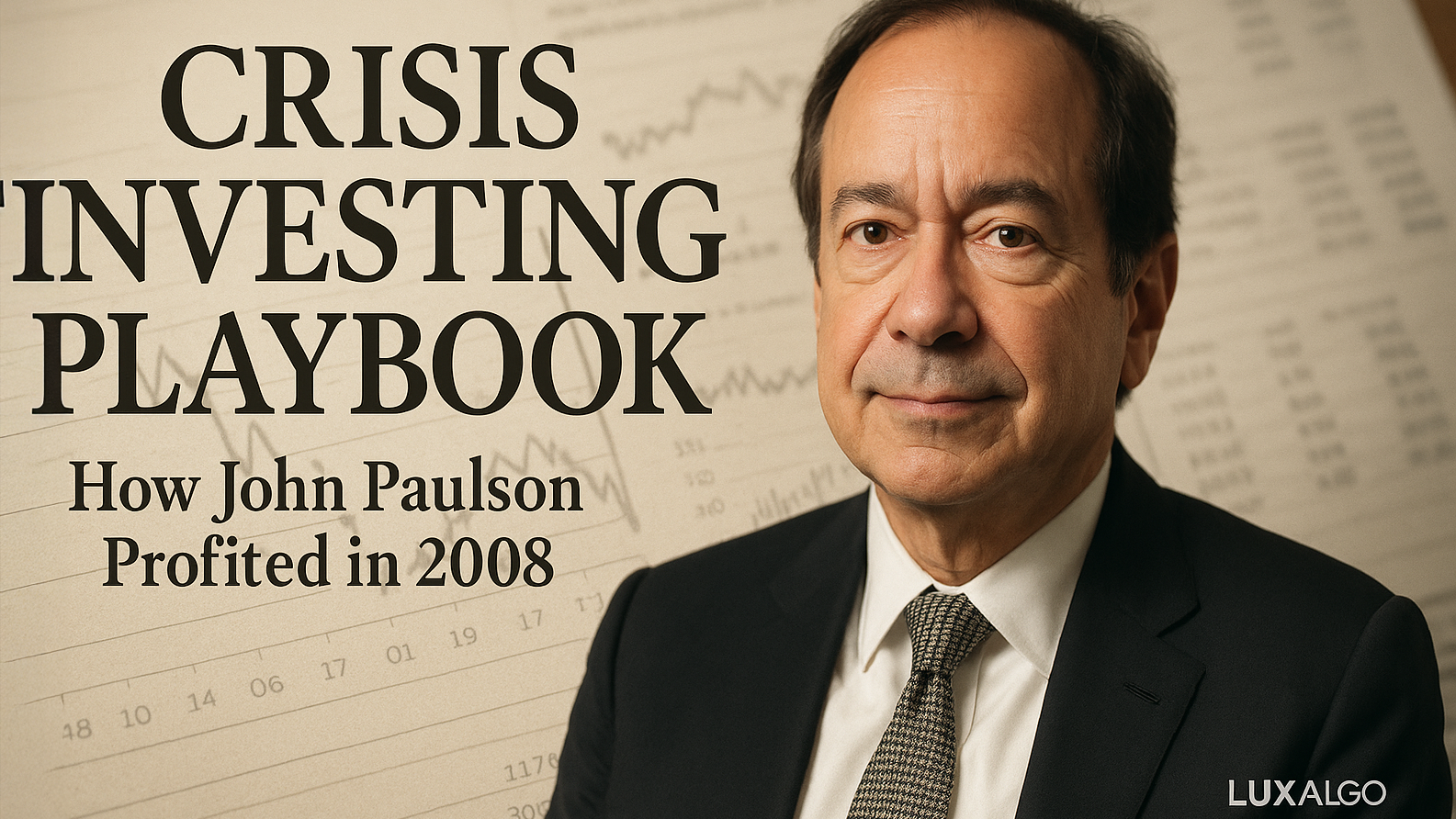Explore key strategies for profiting during market crises, focusing on risk management, market signals, and tactical trading approaches.
Want to profit during a market crisis like John A. Paulson? Here's how he turned a $22 million investment into $1 billion during the 2008 financial meltdown. His approach focused on protecting the downside, spotting market signals early, and disciplined risk management.
Key takeaways from Paulson's strategy:
- Watch for warning signs: Use indicators like yield-curve inversion, unemployment trends, and the “blood indicator” to predict crises.
- Bet against bubbles: Paulson used credit-default swaps (CDS) to short the housing market when others were overly optimistic.
- Risk management is key: Limit position sizes, maintain cash reserves, and prioritise capital preservation.
- Use recovery phases wisely: Identify oversold assets and rotate into sectors based on economic cycles.
- Stay data-driven: Avoid emotional decisions and rely on thorough analysis over market sentiment.
Paulson’s methods are timeless and can be paired with LuxAlgo’s exclusive toolkits and AI Backtesting platform to enhance your trading strategies. Whether you're spotting a crisis, short-selling, or buying during recovery, his disciplined approach offers a clear roadmap for navigating volatile markets.
How to Spot Market Crisis Signals
Reading Economic Warning Signs
John Paulson, known for predicting financial crises, relied on key economic indicators to identify trouble ahead. One of his tools, the “blood indicator”, measures the ratio of 3-month Treasury Bills to the High-Yield Spread against its 100-week moving average. When this ratio spikes, it often points to an approaching financial crisis. Similarly, a rise in the TLT/XLE ratio—comparing U.S. bonds to energy performance—has historically signalled a “flight to safety”, as seen before the 2008 financial meltdown.
Two other metrics can offer critical insights:
- Unemployment trends: When unemployment rises above its 2-year average, it often signals an increased risk of recession.
- Yield-curve inversion: If the inversion surpasses 80%, the likelihood of a recession becomes alarmingly high.
These indicators highlight how shifts in economic data can challenge and overturn market expectations.
Going Against Market Consensus
Market sentiment plays a crucial role in spotting crises. Back in 2005, while most investors were optimistic, Paulson noticed troubling signs in the credit markets that others ignored. His decision to go against the crowd paid off significantly—his Credit Opportunities Fund skyrocketed by 340 % in the first nine months of 2007.
Market Analysis with LuxAlgo Toolkits
For those looking to emulate Paulson's approach, LuxAlgo’s exclusive toolkits on TradingView help detect early signs of market stress. The Oscillator Matrix toolkit focuses on identifying:
- Patterns of unusual market behaviour
- Divergences between volume and price
- Signs of trend exhaustion
- Breakdowns in market structure
Just as Paulson combined various metrics to understand market stress, LuxAlgo combines volatility, volume, and divergence analysis to provide a well-rounded perspective. The Signals & Overlays toolkit delivers real-time alerts for potential market turning points. Pairing these technical resources with indicators like the blood indicator and yield-curve dynamics can help investors spot crisis signals before they fully unfold.
Short-Selling During Market Crashes
Using Credit Default Swaps
John Paulson's approach to profiting during market downturns relied heavily on credit-default swaps. Back in 2005, he spotted the warning signs of unsustainable growth in the U.S. housing market and devised a plan to target subprime mortgage-backed securities. Working alongside Greg Lippmann from Deutsche Bank, Paulson focused on acquiring CDS positions on what he referred to as the “worst of the worst” mortgage bonds.
Paulson zeroed in on struggling mortgage pools, disregarding both credit ratings and the market's reassurances. The introduction of the ABX index in 2006 gave him a game-changing tool, enabling him to scale his strategy and place significant bets against newly issued collateralised-debt obligations (CDOs).
“This [market] is like a casino. Is there a bubble we can short?” — John Paulson
This calculated approach laid the groundwork for carefully timed trades and effective cash management.
Trade Entry and Cash Management
Paulson's success hinged on his disciplined approach to trade entry and managing cash reserves, with a strong emphasis on protecting his capital and navigating volatility.
“Watch the downside, the upside will take care of itself. That's been a very important guiding philosophy for me. Our goal is to preserve principal, not to lose money.”
| Risk-Management Component | Implementation Strategy | Purpose |
|---|---|---|
| Position Sizing | Reduce exposure by 25–30 % during high volatility | Safeguard capital during uncertain periods |
| Stop-Loss Strategy | Use wider stop-loss levels during breakout trades | Adapt to increased market fluctuations |
| Cash Reserves | Maintain ample cash for scaling opportunities | Allow flexibility for position adjustments |
This careful management of cash and risk underscored Paulson's ability to stay focused on capital preservation, especially during times of crisis.
Short-Selling With LuxAlgo Toolkits
Similar to Paulson's methodical approach, LuxAlgo’s Price Action Concepts and Oscillator Matrix toolkits on TradingView help traders execute precise short-selling strategies. Features useful for short-sellers include:
- Automated identification of bearish Change-of-Character (CHoCH) patterns
- Analysis of Fair-Value-Gap (FVG) mitigation
- Detection of bullish order blocks to pinpoint exit opportunities
- AI-driven backtesting to fine-tune stop-loss levels
By combining these advanced features with Paulson's focus on protecting the downside, traders can craft more effective short-selling strategies for turbulent markets.
Crisis Risk-Control Methods
Trade Size and Portfolio Balance
John Paulson's approach to risk control revolved around careful position sizing and maintaining a well-balanced portfolio. He generally capped individual positions at 2.5 % of the portfolio. However, for trades he had strong confidence in, he would increase this to 10–12 %. This disciplined strategy played a significant role in growing his firm's assets from $12.5 billion in June 2007 to an impressive $36 billion by November 2008.
Market-Sector Links and Trade Crowding
Paulson's strategy also prioritised understanding how different market sectors are connected and steering clear of trades that were overly crowded. This approach helped him avoid the risk of amplified losses during periods of market stress. His arbitrage funds, for example, delivered approximately 17 % returns, outperforming the S&P 500's 10 %. This success came from a combination of analysing sector relationships, conducting rigorous stress tests on portfolios, and steering clear of deals involving financing contingencies or market-outs.
These principles of risk control align closely with the advanced resources available through LuxAlgo.
Risk Tools in LuxAlgo
LuxAlgo draws inspiration from Paulson's disciplined methods, providing real-time risk monitoring, correlation tracking, and custom alerts for key thresholds. Traders can also perform portfolio stress testing through the AI Backtesting Assistant and apply advanced position-sizing calculators that factor in volatility metrics.
“Risk arbitrage is not about making money, it's about not losing money. If you can minimise the downside, you get to keep all your earnings and that helps performance.”
Buying During Market Recovery
Finding Oversold Assets
During market-recovery phases, Paulson concentrated on spotting assets that had been heavily sold off during periods of panic but still maintained strong fundamentals. His strategy relied on analysing key indicators to separate short-term market sentiment from actual declines in value.
Market-Sector Rotation Strategy
Paulson's sector-rotation framework divides the economic cycle into specific phases, each favouring certain sectors:
| Economic Phase | Primary Sectors | Secondary Sectors |
|---|---|---|
| Full Recession | Cyclicals & Transports | Technology, Industrials |
| Early Recovery | Industrials | Basic Materials, Energy |
| Late Recovery | Energy | Consumer Staples, Services |
| Early Recession | Services | Utilities, Cyclicals & Transports |
This strategy highlights how market trends often predict economic recovery well in advance.
Market Recovery with LuxAlgo
LuxAlgo's toolkits and AI Backtesting platform help traders identify recovery phases and potential entry points. The Oscillator Matrix provides insights into divergences and money flow, making it easier to detect early signs of recovery. Meanwhile, the Signals & Overlays toolkit offers signal algorithms to pinpoint opportunities in sector rotation and market bottoms.
Additionally, the AI Backtesting Assistant allows traders to test sector-rotation strategies under various conditions. By combining technical analysis with backtesting, traders can implement recovery strategies inspired by Paulson with greater accuracy.
“Economic cycles have been fairly consistent since 1854,” according to data from the National Bureau of Economic Research (NBER).
These resources create a strong foundation for navigating the psychological challenges of trading in volatile markets.
Trading Psychology in Crisis Markets
Avoiding Panic Selling
Keeping emotions in check is critical when trading during a market crisis. Paulson's strategy underscores the importance of staying objective, especially during periods of extreme volatility. Instead of chasing returns, his focus is on protecting against losses, helping to avoid decisions driven by emotions.
Here's how Paulson's systematic risk-management approach tackles emotional triggers:
| Emotional Trigger | Control Strategy | Implementation Method |
|---|---|---|
| Market Panic | Stress Testing | Regular portfolio stress tests |
| Fear of Loss | Position Sizing | Setting position limits based on risk tolerance |
| FOMO | Diversification | Allocating across uncorrelated assets |
This disciplined framework ensures decision-making is driven by data rather than emotional reactions.
Following Numbers, Not Headlines
Paulson's ability to navigate crises successfully lies in his unwavering commitment to data-driven decisions. Instead of being swayed by market sentiment or sensational headlines, he relies on thorough financial analysis and insights from SEC filings.
“Generally, while it is important to reduce exposure or close out the deal if the risk is serious, avoid panic.”
His key principles include:
- Conducting in-depth financial analysis before entering positions.
- Understanding the true value of assets, beyond their current market prices.
- Maintaining a consistent evaluation process, regardless of market conditions.
This reliance on data is further bolstered by automated systems that help filter out market noise, allowing for more objective decision-making.
Setting Up LuxAlgo Trade Alerts
To complement a data-focused approach, automated alerts can be a game-changer in removing emotional biases. LuxAlgo’s alert system helps traders adopt Paulson’s disciplined methodology by enabling precise, automated monitoring.
With the Custom Alert Creator inside the Signals & Overlays toolkit, traders can set notifications based on specific technical criteria rather than reacting to simple price fluctuations. The toolkits available, such as the Oscillator Matrix, provide advanced insights like divergence detection and money-flow trends. These features help traders spot potential market turning points without letting emotions take over.
Additionally, the alert system enables robust monitoring of:
- Divergences between price and technical indicators
- Volume patterns that could signal institutional activity
- Market-structure breaks, which may indicate trend reversals
“Risk arbitrage is not about making money, it's about not losing money. If you can minimise the downside, you get to keep all your earnings and that helps performance.”
John Paulson Tells the Story of Wall Street's “Greatest Trade”
Conclusion: Main Points from Paulson's Methods
Paulson's remarkable achievement in 2008—growing assets from $12.5 billion to $36 billion—is a testament to the importance of rigorous analysis and disciplined risk management. His strategy revolved around spotting opportunities where the potential rewards far outweighed the risks, particularly in distressed markets.
At the heart of Paulson's success was his ability to capitalise on asymmetrical risk-reward opportunities. A prime example is his legendary $4 billion profit in 2007, achieved by betting against the housing market. This systematic and calculated approach became a cornerstone of his methodology.
Today, traders can draw from Paulson's principles and integrate them with modern resources to enhance their strategies:
| Paulson Principle | Modern Implementation | LuxAlgo Integration |
|---|---|---|
| Downside Protection | Regular portfolio stress testing | Market-Structure Oscillator for analysing trend momentum |
| In-Depth Research | Detailed financial-statement analysis | AI Backtesting Assistant for validating strategies |
| Risk Management | Position sizing and diversification | Custom Alert Creator for real-time risk monitoring |
These examples highlight how Paulson's timeless strategies can be adapted to fit today's trading environment. His focus on protecting capital continues to resonate, as seen in his 2023 investment in Thryv Holdings Inc. (THRY). This move was backed by strong fundamentals, including $1,113 million in Digital-Marketing revenue (up 7.99 % year-over-year) and $101.6 million in SaaS-Solutions net income (a 320 % increase year-over-year) (Source: John Paulson: Methods and Trade Insights, LuxAlgo.com, 6 May 2025).








